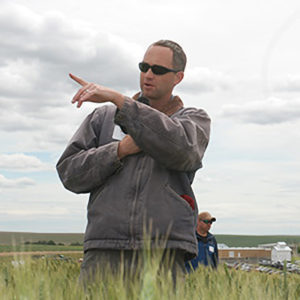Molecular technology has been rapidly changing in the past 20 years, making my job as Washington State University’s winter wheat breeder more complicated, and more streamlined simultaneously.
There are many different aspects of “molecular technology.” Manipulating genetic material and cellular process is part of it, but so are innovations in computational and manufacturing technology.
On that last point, consider that just 12 years ago, while working on my PhD, how amazed I was by the innovative molecular technology I had available. We moved from plates that could hold 96 genetic samples for evaluation to plates that could hold 384 (a four-fold increase!) New pipettes allowed me to move 12 liquid samples at a time.
With the technology I could set up a 384 well plate to run four different DNA markers on 96 samples in about an hour. Then, once the PCR reaction was complete, I had a machine that could visualize 96 samples at a time, and only took 90 minutes to run. Within a day, I could set up and run about 12 markers and have them visualized. With the thousand markers I needed to run, it only took me about three months to collect the genotypic information I needed for my research! Life was good—and amazing!
But time does not stand still. A trip to Illumina two years ago put everything in perspective. A company that manufactures molecular equipment, some of Illumina’s new machines can run 1,152 samples at a time (three of my 384 well plates), and evaluate multiple markers at a time. What took me three months to complete 12 years ago, takes them a couple of days to accomplish. Today, our newest DNA marker technology actually allows us to run tens of thousands of markers in about a week’s time. More than enough for the plant breeding work we are interested in doing—and all for only $40 per line.
Now that we have looked at how the technology has changed, let’s look at how we use the technology. DNA markers are small sequences of DNA that are closely linked to a particular gene we are interested in. For example, we have DNA markers that are linked to highly effective stripe rust resistance genes. We can use these DNA markers to select early generation breeding material so that we only advance lines carrying resistance genes. These lines are then moved to the field for validation, as you can get some false-positives using markers alone.
We then combine this selection with other DNA markers for traits such as eyespot foot rot, end-use quality, and a host of other stress tolerance traits. With many selections being made in the greenhouse, we only advance selected breeding lines to field testing. Our field program still tests the same amount of lines in field trials, but we are now guaranteed these lines contain genes for important traits required to make a successful cultivar. Field testing continues to look at traits for which we do not have good DNA markers for, such as yield potential, high test weight, and adaptability across environments.
But wait! Why even run DNA markers anymore? Over the past few years genome sequencing technology has become the buzz. The wheat genome has been sequenced and a new protocol of genotyping lines just by sequencing them has emerged. No more need to run individual markers. Now, in about a week, I can do genotyping by sequencing on as many lines as I want for only $7 per sample. While we can still look at the presence or absence of individual genes using this technology, it also opens the door to use what is called genomic selection.
Genomic selection evaluates every DNA sequence in the individual breeding line and gives an estimate of the value of that line. Using statistical models, which have incorporated the performance of thousands of lines over multiple locations and years, we can begin to understand whether each DNA sequence identified is valuable or not.
Now, when I have a new breeding line, I can simply sequence it and run the selection model. The program will then tell me how many valuable sequences the line has. The more valuable sequences, the more probable that line will be successful under field testing. Lines which have very few valuable DNA sequences can be discarded before field testing. It is like picking your All-Star team before the season has even begun.
This has been a simplistic view of how we can use molecular technology within the breeding programs, but hopefully it provides a glimpse into what we can now do to advance the breeding process. To paraphrase an advertisement for the now defunct Oldsmobile brand: This is not your father’s wheat breeding!
Selection using molecular technology can speed up the process, ensure certain genes and traits are in the breeding lines, and make predictions about which lines will be the most successful. While it does not allow us to test more lines in the field, it does allow us to test the best lines in the field, which will allow identification of superior varieties in a shorter time frame and with more confidence. The only question now is what will another 20 years bring?

